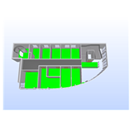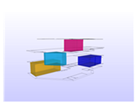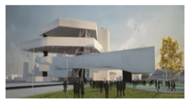Abstract
Building information modeling (BIM) technology has been utilized increasingly in quantitative ways in the architecture, engineering, and construction disciplines. However, owing to increasing requirements for improvement in qualitative factors in BIM-based design projects, it has become necessary to develop a checking and evaluation process for BIM-based architectural design. The purpose of this study is to develop and apply BIM-based quality control requirements for improving the quality of architectural design. To achieve this, the research investigated case studies for BIM data quality control and classified quality control targets according to physical/logical quality and data quality. The quality check criteria and checklists are developed through the reconfiguration of deduced quality control targets by requirement. The research developed a rule-based quality checking system using requirements for efficient quality control based on BIM.
1. Introduction
The construction industry relies on a vast array of architectural information, as an architectural process includes a variety of design stages and the cooperation of many disciplines. In particular, architectural information is generated and managed throughout the life of a building, from the conceptual design stage to construction and maintenance [1]. Building information modeling (BIM) technology improves the productivity and efficiency of the construction industry by taking advantage of the information generated throughout the life cycle of the facility to build a consistent system to maximize production efficiency and utilization of information [2].
BIM has actively been adopted to support the productivity of the construction industry. Further, public institutions in advanced countries (e.g., the United States [US], United Kingdom, Singapore, and South Korea) have mandated the implementation of BIM in design delivery, and promote automated checking for BIM quality [3]. This has a strong influence by promoting practices that use BIM. Improvements in work efficiency and productivity occur as a result of BIM adoption, depending on the consistency and accuracy of data [4]. The purpose of quality control in construction work is to ensure a structure is built in a rational, economical, and durable way. Improvement in quality reliability and reduction in costs can be achieved by securing a certain quality, improving quality and maintaining constant quality in the overall project [5]. Therefore, quality control is a very important factor in terms of project management. Quality control requirements are included in the BIM guidelines of some countries (e.g., Finland, USA, and Denmark). However, requirements for quality control are insufficiently detailed in current general BIM guidelines. There are limitations in adopting these guidelines into detailed work practices [6,7].
BIM technology has been utilized increasingly in quantitative ways in the architecture, engineering, and construction (AEC) disciplines. Owing to recently increased requirements for the improvement of qualitative factors in BIM-based design projects, various quality checks are performed using BIM-based checking software. However, there are problems with this, such as a lack of BIM-based evaluation requirements [8]—reflecting the design changes that occur continually in the design phase [2,9]—and a lack of automated quality check processes through quality checking systems [10,11,12]. Therefore, it is necessary to define the checking and evaluation process and develop checking software for quality improvements to a BIM-based architectural design model.
The purpose of this study is to develop and apply quality check control requirements for improving the quality of architectural design based on BIM. To achieve this, the study defined quality check targets for the BIM-based design phase by analyzing the work and output information of each stage of the architectural design process and extracting detailed quality check targets from status (e.g., BIM guidelines, rule-based quality checking software) and domestic regulations. In addition, the research developed quality check requirements consisting of space check criteria, design check criteria and construction check criteria according to the nature and purpose of the work. Finally, the research developed a rule-based quality checking system using requirements for efficient quality controls based on BIM. The quality check requirements, which consist of classified targets to be considered when creating and assessing BIM data by designer and evaluator, could become necessary for common works in the design process. Therefore, an improvement in design quality could be expected when these quality control requirements are actively utilized.
The methodology employed in this study is as follows:
- The applied design phase was defined by analyzing the work and output information for each stage in the design process.
- Quality check targets were deduced through advanced practices (e.g., guidelines, software) and domestic regulations.
- Quality check requirements consisting of a space check, design check, and construction check were developed by categorizing the subject of the quality control according to the object and purpose of the works. Regulation checking is included in the design check criteria.
- A process of definition and development of element technologies was suggested for applying quality control to architectural design based on BIM. The results of quality checks were validated using rule-based quality checking software.
2. Literature Review
2.1. Overview of BIM-Based Quality Control
A building information model is a digital representation of the physical and functional characteristics of a facility. As such, it serves as a shared knowledge resource for information about a facility, forming a reliable basis for decisions during its life cycle, from inception onward [13]. As stages in the architectural process proceed, information is added and merged continuously. BIM applies parametric technology, where intelligent building objects can represent the geometric information, spatial relationships, geographic information, quantities and properties of building objects, material inventories and project schedules [14,15]. In paticular, BIM is useful for quality control using building object properties such as characteristic and relation information for various disciplines.
As an aspect of BIM, quality control encourages correct utilization of data, and quality checks review the validity of the physical and logical information to increase productivity. Quality control requirements based on BIM according to the goals and objectives of quality checks can be classified as shown in Table 1 [16].

Table 1.
Classification of quality control based on building information modeling (BIM).
BIM has been actively adopted in the construction industry because of an awareness of the importance of utilizing and assessing design information. However, there are problems with current quality control:
- It is difficult to define the information to be delivered to each subsequent stage in the design phase and to utilize the delivered information at the next stage; due to the lack of definition of the work and requirements for each design stage [17].
- Design information quality control should be performed continuously to reflect the design changes that occur throughout the design phase. However, immediate reflection is typically not performed properly because requirements and software for quality control are lacking [2,11].
- As a construction project progresses, the amount of information that must be analyzed and checked increases. Most regulation checking is still performed manually, which is error-prone and reduces work efficiency [3,10,18,19].
- The lack of requirements and guidelines related to BIM degrades design quality. Although some BIM guidelines include quality control requirements, there is a lack of detailed requirements for quality control in such guidelines. Further, there are limitations with the guidelines to be adopted in quality control work practices [4,9,20].
2.2. The Status of Guidelines for Quality Control
Many governments have been developing BIM guidelines for various sectors to institute the adoption of BIM. Some BIM guidelines deal with quality control either directly or indirectly. Although some aspects of quality control are included, the exact scope and content of quality control is still insufficient. Table 2 provides a summary of the various aspects of quality control in the BIM guidelines dealing with quality control.

Table 2.
The status and content of BIM-based guidelines for quality control.
2.3. The Status of Quality Control Software
Quality control software that is rule-based is able to perform an accurate and detailed clash check of physical BIMs. Navisworks and the Solibri Model Checker (SMC) are two leading software programs in the construction industry that can check model quality based on BIM. Navisworks has strengths in 4D and can only perform physical checks such as a clash check [30]. The SMC is the most common and widely used tool for BIM quality control in the GSA of the US, senate properties in Finland and bips in Denmark. The SMC was also used during the building design of the Korea Power Exchange headquarters as a tool for quality checks [31]. The SMC can perform various functions such as space, accessibility, structure, constructability, and regulation checks through a rule set that the user defines [10]. The Building and Construction Authority (BCA) of Singapore and the Ministry of Land, Infrastructure and Transport (MOLIT) of Korea are also developing a system that can check BIM-based building permission code [32,33]. BCA targets accessibility among building permission codes, and Korea has SEUMTER that checks building permission codes. In these projects, software that can automatically check each building permission code has been developed and applied.
2.4. Case Applications of Quality Control
The projects presented in Table 3 referred to the BIM guidelines and managed the BIM quality accordingly. The contents presented in this table show that the BIM guidelines referenced from the project are all different, but common information such as space check, flash check, etc. is required for quality control.

Table 3.
Case studies for quality control.
2.5. Summary
The status of quality control using BIM was reviewed in terms of guidelines, software, and applications. In addition, there are methods for checking quality according to specific purposes such as building permission codes, safety, evacuation, cost, energy, etc. As mentioned in the Introduction, the current status is in a transitional phase in which plans of development and application are continuously evolving through the recognition of the importance of quality control. Limitations and additional requirements affect the overall status. However, some examples are directly or indirectly reflected in the quality control requirements to be developed in this research. Rule-based quality check software contains rules that make basic quality checks available; they can be extended by creating new rules for additional design requirements. Such rule-based quality checking software is being used in various applications for quality control. The SMC was utilized to validate and apply the criteria for quality checking developed in this paper. Most BIM guidelines refer to quality control but simply highlight its importance. Detailed components and the methodology for quality control are lacking. Therefore, a detailed plan that defines the application and scope of the requirements for quality control is needed. The development of guidelines that provide detailed requirements for quality checking is the purpose of this research. Common applicable elements and additional elements required for domestic regulation are derived.
The applications of quality control analyzed in this paper were focused largely on physical checking (e.g., clash checking). Rule-based checking systems supporting quality control and quality checking in logical aspects have been planned and developed for more effective quality control. Many applications verifying the requirements developed in this paper should be continuously conducted to establish suitable quality control for the domestic practice environment. An application plan for automated quality control should be identified as a way of applying the requirements of quality control.
3. Design Quality in Design Processes Based on BIM
In this study, the design process defined in domestic and international guidelines has been identified based on BIM. The traditional design process has been changed with the adoption of BIM. In traditional design processes, a substantial component should be handled in the construction document stage. However, in the BIM process, all participants (e.g., owner, architect, and contractor) collaborate on the work at all stages. If a main operator or special contractor has construction know-how, any design uncertainty and the construction period can be reduced, and construction quality can be improved [31].
Quality control targets should be established first in developing quality control requirements for improving the quality of architectural design. To this end, this research reviewed guidelines that include information about the application of BIM by the work process phase. The terms that define the process phases differ, but the basic concept is largely the same. Table 4 presents quality control targets based on the IPD stage [39], through analysis of the design process. IPD is an integrated project delivery method that optimizes project efficiency through the collaboration of all participants at all phases of the construction industry [39]. Some parts of the construction stage are excluded because the information considered is centered on architectural design.

Table 4.
Quality control targets by stage through analysis of the architectural design process.
4. Development of Design Quality Check Criteria Based on BIM
To increase the reliability of design assessments and quality check results, the definition of the design phase work and criteria that reflect business requirements is necessary. The environment that can be applied to this system should then be established. Therefore, this section presents quality check criteria based on BIM through a review of the target of quality control, and the development of checklists for checking details (see Figure 1). Architectural process based on BIM controls quality through BIM guidelines, building permission code, and rule-based S/W. These three quality controls can be classified into quality check requirements according to the level of application, scope, and level.
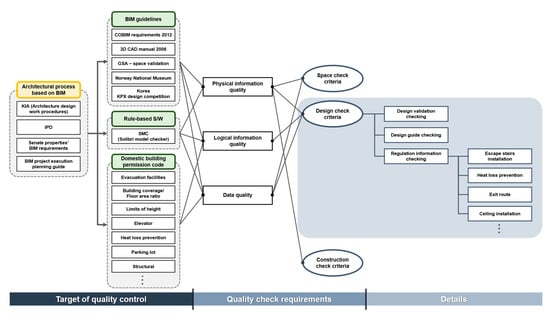
Figure 1.
Relevance of quality control target and criteria.
4.1. Review of Quality Check Targets Based on BIM
This research reviews detailed quality control targets deduced from BIM guidelines and the rule-based software for quality checks based on requirements of analysis for the BIM-based design process. To reflect the domestic situation, targets of quality control that reflect Korean regulations are also deduced. Quality control targets are classified as physical information quality, logical information quality, and data quality.
The applied targets for quality checks are preferentially selected, applicable, and generalized quality check targets, rather than checks for a specific item. However, the current contents are the basic steps. The targets should be appropriate for the goals of a specific project, established in the future through the identification of additional check targets. In the case of logical information and quality-based regulation checking, quality check target review work should be progressed continuously. Table 4 excerpts from IPD, Finland, and South Korea, although the methods vary for quality control targets. Quality control targets are excerpts from common or frequently used ones. These targets are based on the classification as shown in Table 5.

Table 5.
Quality check target arrangements by classification.
4.2. Development of Quality Check Criteria Based on BIM
In this section, quality check criteria and checklists are developed through reconfiguration of deduced quality check targets by requirement. As described above, quality check targets based on BIM can be classified into physical information quality, logical information quality, and data quality. For practical applications, they can be separated into space check criteria, design check criteria, and construction check criteria, depending on the applicable goals and methods. The deducted quality check targets and the relevance of criteria developed in this study are shown in Figure 1.
The targets of quality checking are spatial checking and design checking for improving design quality and construction checking. In addition, escape stairs installation criteria and heat loss prevention criteria are presented for regulation information checking in design check criteria.
4.2.1. Space Check Criteria
Space check criteria are related to the checking of space components, space name, space area, and clash between spaces in the BIM according to the space programming required by the client. BIM that includes spatial information is referred to as spatial BIM. The spatial BIM is checked to determine whether the space programing is reflected appropriately.
4.2.2. Design Check Criteria
Design check criteria are related to the checking of BIM data quality generated in the design process. These criteria have additional components including BIM validation and design guidelines. Further, they contain regulation information and related design. Detailed installation criteria for escape stairs and heat loss prevention are developed in this research. The regulations can be modified and supplemented depending on the intended use of the BIM.
4.2.3. Construction Check Criteria
Construction check criteria are related to the physical quality checking of BIM data for constructability checking. Generally, such criteria refer to clash checking between the same kinds of building objects and different kinds of building objects.
Table 6 presents some examples of the quality check criteria developed in this study.

Table 6.
Quality check targets and cases.
4.3. Development of Quality Check Checklists
This research developed specific checklists considering items and procedures according to the quality check criteria developed in the study. These checklists can prevent missing information, making it possible to increase the accuracy of information about the required targets and contents. Through the use of these specific checklists, architects and designers are able to reflect design changes with continuous self-diagnostics. This is very important to improve quality checking results.
Table 7 presents an example of a checklist based on the design check criteria. This checklist contains commonly applicable content in the case of the Power Exchange headquarters competition [28] through analysis of processes and requirements. The heat loss prevention criteria that are the target of regulation checking are also included.

Table 7.
Example of checklist for design check criteria.
5. Application of Design Quality Checks Based on BIM
5.1. Suggested Quality Checking Process
For application to quality check-based BIM, quality check software that reflects quality check criteria and BIM data generated according to the BIM guidelines should be configured as shown in Figure 2. The quality check software can be applied to modify existing rules according to the criteria developed for the quality check. Additionally, quality check software should enable users to develop rules directly for automated quality checking according to altered criteria (e.g., revised regulations).
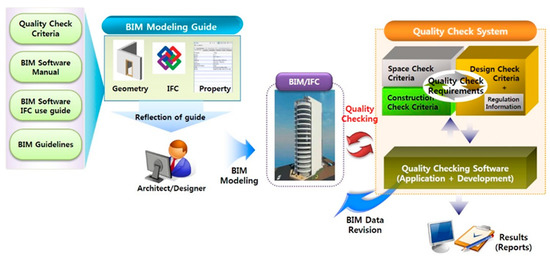
Figure 2.
Process and element technology for the application of quality checking.
The suggested quality check process is as follows:
- (1)
- The architect and designer produce a design plan with quality check criteria using BIM software. In this case, it is necessary to define the building object’s properties according to BIM guidelines for the quality check.
- (2)
- The BIM created using the BIM software is exported in the IFC format [36].
- (3)
- The BIM data are checked according to the quality checking criteria using quality check software. The architect and designer continually revise and review the design until the design requirements are properly reflected in the BIM data through the quality checking criteria.
- (4)
- The quality checking results can be reported.
5.2. BIM Data
A BIM created according to BIM guidelines is needed to conduct quality checking. The BIM guideline can lead architects/designers and evaluators to create quality models that can be used to perform quality control and to increase the reliability of quality control results. These BIM guidelines should include not only basic modeling methods but also additional property definitions according to quality control criteria. The information input level for the BIM is LOD 2 [44] in the design development phase. At this level, it is possible to define the details of the design check criteria and the construction check criteria among the quality check criteria. In this research, since the open BIM environment [27] is applied for effective sharing and exchange of design information, BIM data format adopts IFC 2x3 or higher standard format [36]. IFC are the main building SMART data model standard and this format is registered by ISO as ISO 16739. IFC can be used to exchange and share BIM data between applications developed by different software vendors without the software having to support numerous native formats. As an open format, IFC do not belong to a single software vendor therefore they are neutral and independent of a particular vendor’s plans for software development [36].
5.3. Application of Rule-Based Quality Checking Software
To achieve an effective quality check based on quality check criteria, quality evaluation using quality checking software is very important. Depending on the purpose and nature of the quality check criteria, some criteria can be checked using the rules provided by the existing software.
5.3.1. Quality Checking Using SMC (Modification and Addition of Rule Sets)
The criteria developed in this study can be utilized with some modification of existing SMC rules according to quality check criteria. SMC provides various rules and types of rules set by a group depending on the type and purpose [4]. A new rule set can be created by combining various kinds of associated rules with the quality check criteria developed in this study. Each rule set can be configured in association with the criteria. Figure 3 shows the results of a quality check conducted by a recombinant rule set according to the space check criteria.

Figure 3.
Example of quality check according to the space check criteria.
5.3.2. Development of Rule-Based Quality Check Software
(1) Structure quality checking criteria
The design check criteria (focused on regulation information) and methods should be defined based on the relevant regulations for a rule-based quality checking system. The defined design checking criteria should be coded for regulation checking by linking the BIM data and regulation code. Rule-based regulation checking progresses through the identification of the targets and contents of building objects in BIM data compared with the regulation code.
The BIM property information contains the names of materials that have further applicable information for various disciplines. This property information is utilized to determine quality checking results in the rule-based quality checking system. Software can be communicated using a neutral format throughout the open BIM environment, such as IFC, which is an international standard [27,36,45]. Open BIM is a universal approach to the collaborative design, realization, and operation of buildings based on open standards and workflows [27]. IFC provides the definitions for additional property information through the development of a property set (PSET) in the extension of the concept model for the definition of additional attributes of the BIM [16,36]. buildingSMART provides basic PSETs (e.g., Pset_WallCommon) along with a methodology for defining additional properties for building objects. The PSETs and properties for applying the regulations (e.g., heat loss prevention criteria) are shown in Figure 4.
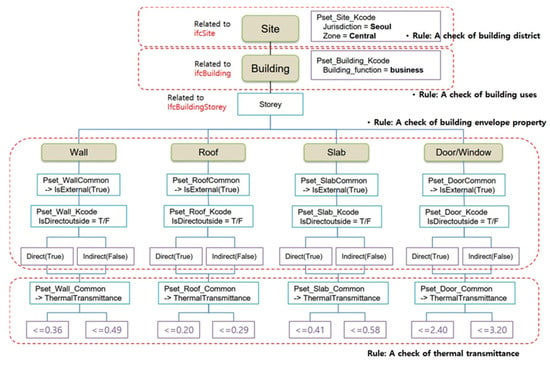
Figure 4.
Definition of rules for applying regulations (e.g., heat loss prevention criteria).
(2) Development of rules through the SMC API environment
As described above, SMC can be utilized for all of the developed quality check criteria. Therefore, this study uses SMC as the software for rule-based quality checking.
Regulation information should be structuralized in conjunction with IFC for using rules that are related to regulations in the SMC [36,46]. The rules have to be defined as a separate class (Java file) in the SMC Java API environment (See Figure 5), and the required properties and checking order must be defined with IFC structure and regulation contents [36]. This study focuses on heat loss prevention regulation checking criteria and generates the coded Java file from delimited rules (e.g., a check of building district, building uses, building envelope property, and thermal transmittance).

Figure 5.
Eclipse Interface defining rules for building envelope property definition.
The thermal transmittance (U-value) is obtained by
A new rule set that corresponds to the heat loss prevention criteria is generated with one of the rules (Java file) developed in the Rule Set Manager of SMC.
The heat loss is obtained by
- A: Surface area
- ∆T: Temperature difference (T1, T2)
Regulation checking is then conducted in conjunction with the BIM data. It is necessary to continuously modify errors that occur through regulation checking; a final design can be derived after regulation checking is completed. In particular, final design checking criteria can be utilized by legality checking for building permission [4]. Figure 6 shows the rule-based quality checking result according to design check criteria.
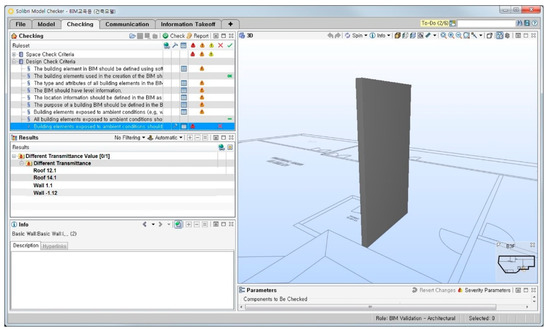
Figure 6.
Example of rule-based quality checking results according to design check criteria (e.g., criterion, heat loss prevention; rule, thermal transmittance checking).
(3) Development of rule-based quality check software
The development through the API environment of a specific program may cause problems such as limitations and dependencies of the API module. Therefore, in this research, we developed software that can develop the self-developed function and check it. This software provides the text of select code articles from the Korean Building Act, its enforcement decrees, and the regulations associated with them. The rule is defined and managed with building code checklists based on those currently used in actual architectural firms. The rules are based on the quality checking criteria, and the system library functions and the scripts are generated by the rules.
In the case of a check of elevator installation criteria, the number of elevator installation is obtained by
Figure 7 is an example of a flowchart for analyzing the regulation before the development of rules and software.
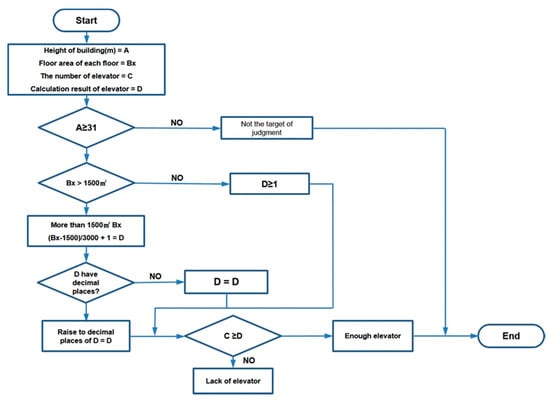
Figure 7.
Flowchart for checking installation of elevator.
Figure 8 shows the process of applying a rule to check the installation of the ceiling.
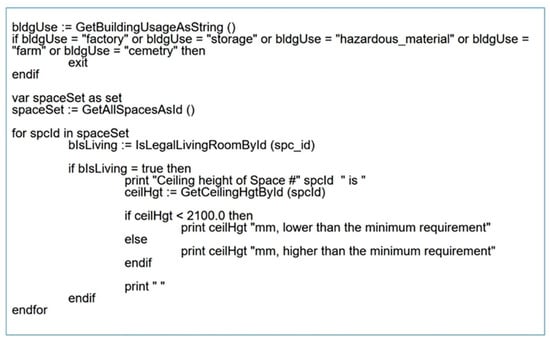
Figure 8.
Example of scripting using rule (e.g., installation of ceiling).
Figure 9 shows the result of the quality checking as exemplified in the installation of the ceiling and the functions of software.

Figure 9.
Example of rule-based quality checking results according to design check criteria (e.g., installation of ceiling).
6. Usage and Verification of Proposed Quality Checking Requirements
6.1. Overview
In this section, a quality check of BIM data was performed to validate the applicability of the developed quality check criteria, by using rule-based quality check software. Some of the criteria for space and construction checks were established based on modifications to the basic rules supported by SMC, as previously mentioned. For the design check criteria, heat loss prevention criteria were additionally developed, and these also were adopted in quality checks. Revit and ArchiCAD were used as the BIM software. The properties of regulation information in the design criteria were input with basic modeling according to the LOD of BIM, as suggested in this study. A summary of the application example models is provided in Table 8.

Table 8.
Overview of case models.
6.2. Results of the Applied Criteria
The developed quality check criteria, which consist of a space check, design check and construction check were applied. Continuous quality checking and revision allowed the improvement of the final design plan. This may provide a basis for improving accuracy and efficiency in aspects of project management.
6.2.1. Space Check Criteria
Space check criteria are the criteria for evaluating whether BIM data reflects the space program. In this study, the basic rule set in SMC was modified to develop targeted model-specific rules for the space program. A quality check on this rule was performed. Table 9 shows the results from the quality check for each case model.

Table 9.
The result of quality checking against space check criteria in case models.
Problems identified in the quality check based on space check criteria are described in Table 10. In addition, solutions to these problems are suggested.

Table 10.
Results of quality checking based on space check criteria.
6.2.2. Design Check Criteria
The design check criteria evaluate whether BIM data reflect the design guidelines. BIM validation in SMC was utilized. In addition, a quality check on heat loss prevention criteria was conducted. As a result of the quality check on design check criteria, the problems shown in Table 11 were identified.

Table 11.
The results of quality checks against the design check criteria in case models.
As a result of the quality check against design check criteria, the problems shown in Table 12 were identified. Solutions to these problems are also suggested in the table.

Table 12.
The results of quality checks against design check criteria.
6.2.3. Construction Check Criteria
The construction check criteria are related to a physical evaluation of the degree to which construction criteria are reflected. The quality check was conducted after modifying the basic rule set in SMC to derive the rules for the construction check. As a result of the quality check against construction check criteria, the problems shown in Table 13 were identified.

Table 13.
The results of quality checks against the construction check criteria in case models.
During the quality check against construction check criteria, the problems shown in Table 14 were encountered, and the solutions to these problems are suggested in the table.

Table 14.
The results of quality checks against construction check criteria.
6.3. Analysis of the Results and Achievement
As described above, the verification process of the proposed quality checking requirements was conducted. According to the characteristics of the case model, the achievement of the quality check result by the quality check target was different. The achievement of the quality checking is obtained by
In detail, the achievement of the quality check target for Case 1 is shown in the following Table 15 and Table 16.

Table 15.
The achievement score by criteria.

Table 16.
The achievement score by quality check target.
According to the quality checking requirements proposed in this study, the comparison of achievement according to the quality checking results of each case model is shown in the following Figure 10. It is possible to secure design quality through continuous quality control by reflecting the result of quality checking.
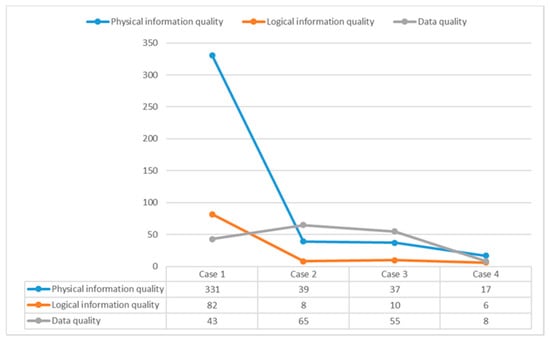
Figure 10.
The comparison of achievement according to the quality checking results.
7. Conclusions
A vast amount of design information exists throughout the construction industry, and design assessment and quality control should be conducted to deal with this information. Continuous checks in the design phase should be made; a BIM-based quality check is an effective way to achieve this. However, BIM-based quality checking cannot be achieved systematically due to lack of criteria and an application plan (e.g., system side), although the approach can reorganize and assess design information.
This study aimed to developed element technology and application plans for systematic quality control, and to improve the quality of architectural design in the BIM environment. Specifically, the research analyzed output information and design phase work in the design process, and then derived detailed quality control targets for a series of cases (e.g., guidelines, software) and Korean regulations. The targets for quality control were developed with respect to requirements for space check criteria, design check criteria, and construction check criteria according to the nature and purpose of the works. The regulation check contents of these requirements were included in the design check criteria. In addition, definitions of the process and development of various required element technologies were suggested for applications in architectural design quality control based on BIM. The results of these quality control processes were verified by quality checking software (including the developed contents) based on rules.
The quality control requirements classified targets to be considered when creating and assessing BIM data, and are essential for supporting common works in the design process. Therefore, design quality could be improved when quality control requirements are actively utilized. In addition, checklists classified by detailed criteria for design requirements can be utilized to track the progress of quality checking through self-checking.
Architects and designers who wish to check design quality in the design process or evaluation can expect improvements in quality by following a step-by-step approach with respect to the detailed checking of results. Rule-based quality checking software can support quality checking according to quality control requirements, and reduce inefficiencies in the use of time and human resources. Errors noted in quality checking results could be minimized by improving the performance of the checking system with respect to the requirements. It is expected that software would maximize the reliability of results and the efficiency of quality control.
The scope of the quality control requirements applied in this study is limited to the design process, and it may be impractical to apply quality control throughout the project’s life cycle. To overcome this limitation, the application scope of quality control should be expanded to various phases such as construction and maintenance.
Author Contributions
Conceptualization, J.C. and I.K.; data curation, J.C., S.L. and I.K.; formal analysis, J.C. and S.L.; funding acquisition, I.K.; investigation, J.C. and I.K.; methodology, J.C.; project administration, I.K.; resources, J.C., S.L.; supervision, I.K.; validation, J.C., S.L. and I.K.; visualization, S.L.; writing—original draft, J.C. and S.L.; writing—review & editing, J.C. and I.K. All authors have read and agreed to the published version of the manuscript.
Funding
This research was supported by a grant (20AUDP-B127891-04) from the Architecture & Urban Development Research Program funded by the Ministry of Land, Infrastructure and Transport of the Korean government.
Conflicts of Interest
The authors declare no conflict of interest.
References
- Kim, I.; Lee, S. Development of an interoperability model for different construction drawing standards based on ISO 10303 STEP. Autom. Constr. 2005, 14, 633–649. [Google Scholar] [CrossRef]
- Eastman, C.; Teicholz, Y.; Sacks, R.; Liston, K. BIM Handbook, 2nd ed.; John Wiley & Sons Inc.: Hoboken, NJ, USA, 2008. [Google Scholar]
- Choi, J.; Choi, J.; Kim, I. Development of BIM-based Evacuation Regulation Checking System for High-rise and Complex Buildings. Autom. Constr. 2014, 46, 38–49. [Google Scholar] [CrossRef]
- Choi, J. Open BIM & Design Information Quality Control; Goomi Book: Seoul, Korea, 2012. [Google Scholar]
- Chen, L.; Luo, H. A BIM-based construction quality management model and its applications. Autom. Constr. 2014, 46, 64–73. [Google Scholar] [CrossRef]
- Choi, J.; Kim, I. Development of an Open BIM-based Legality System for Building Administration Permission Services. J. Asian Archit. Build. Eng. 2015, 14, 577–584. [Google Scholar] [CrossRef]
- Malsane, S.; Matthews, J.; Lockley, S.; Love, P.; Greenwood, D. Development of an object model for automated compliance checking. Autom. Constr. 2015, 49, 51–58. [Google Scholar] [CrossRef]
- Pinheiro, S.; Corry, E.; O’Donnell, J. Requirements for a BIM-Based Life-Cycle Performance Evaluation Framework to Enable Optimum Building Operation. In Proceedings of the 32th CIB W78 Conference 2015, Eindhoven, The Netherlands, 27–29 October 2015; CIB: Rotterdam, The Netherlands, 2015. [Google Scholar]
- Kim, I. Quality Assurance, 7th Buildingsmart Korea Workshop; Kyung Hee University: Yongin-si, Korea, 2009. [Google Scholar]
- Eastman, C.; Lee, J.; Jeong, Y.; Lee, J. Automatic rule-based checking of building designs. Autom. Constr. Rev. 2009, 18, 1011–1033. [Google Scholar] [CrossRef]
- Lee, J. Automated Checking of Building Requirements on Circulation Over A Range of Design Phases. Ph.D. Thesis, Georgia Institute of Technology, Atlanta, GA, USA, 2010. [Google Scholar]
- Sijie, Z.; Kristiina, S.; Markku, K.; Ilkka, R.; Eastman, C.; Jochen, T. BIM-based fall hazard identification and prevention in construction safety planning. Saf. Sci. 2015, 72, 31–45. [Google Scholar] [CrossRef]
- NIBS. Overview Building Information Models; NIBS: Atlanta, GA, USA, 2006; Available online: https://www.nibs.org/page/nbgo (accessed on 9 October 2019).
- Choi, J.; Kim, H.; Kim, I. Open BIM-based Quantity Take-off System for Schematic Estimation of Building Frame in Early Design Stage. J. Comput. Des. Eng. 2015, 2, 16–25. [Google Scholar] [CrossRef]
- Azhar, S.; Nadeem, A.; Mok, J.; Leung, B. Building Information Modeling (BIM): A New Paradigm for Visual Interactive Modeling and Simulation for Construction Projects. In Proceedings of the First International Conference on Construction in Developing Countries (ICCIDC–I), Karachi, Pakistan, 4–5 August 2008. [Google Scholar]
- Choi, J.; Kim, I. Interoperability Tests of IFC Property Information for Open BIM based Quality Assurance. Trans. Soc. CAD/CAM Eng. 2011, 16, 92–103. [Google Scholar]
- Kim, I.; Park, C.; Park, J.; Jung, J.; Choo, S. BIM in Architecture: Design and Engineering; Kimoondang: Seoul, Korea, 2014. [Google Scholar]
- Nguyen, T. Integrating Building Code Compliance Checking into a 3D CAD System. In Proceedings of the International Conference on Computing in Civil Engineering, Cancun, Mexico, 12–15 July 2005; American Society of Civil Engineers: Reston, VA, USA, 2005. [Google Scholar] [CrossRef]
- Vassileva, S. An approach of construction integrated client/server framework for operative checking of building code. In Proceedings of the CIB W78 workshop, Reykjavik, Iceland, 28–30 June 2000. [Google Scholar]
- Georgia Tech. Georgia Tech BIM Requirements & Guidelines for Architects, Engineers and Contractors; Version 1.5; Georgia Tech: Atlanta, GA, USA, 2016. [Google Scholar]
- Kulusjarvi, H. COBIM Common BIM Requirements 2012; Series 6: Quality Assurance; BuildingSMART Finland: Helsinki, Finland, 2012. [Google Scholar]
- Bips. 3D CAD Manual 2006; Bips: Lyngby, Denmark, 2007. [Google Scholar]
- GSA. 3D-4D Building Information Modeling; BIM Guide Series; GSA: Washington, DC, USA, 2007.
- USACE. Building Information Modeling (BIM)—A Road Map for Implementation to Support MILCON Transformation and Civil Works Projects within the U.S. Army Corps of Engineers; USACE: Washington, DC, USA, 2006.
- Statsbygg. Statsbygg Building Information Modelling Manual Version 1.2; Statsbygg: Oslo, Norway, 2011. [Google Scholar]
- Ministry of Land Transport and Maritime Affairs (MLTM). BIM Guide of Ministry of Land Transport and Maritime Affairs; MLTM: Sejong, Korea, 2010.
- Open BIM, BuildingSmart. Available online: http://www.buildingsmart.org/openbim/ (accessed on 31 July 2020).
- KPX. Korea Power Exchange Headquarters Building Construction Design Competition Guideline; KPX: Naju, Korea, 2010. [Google Scholar]
- PPS. BIM Guide of Public Procurement Service v1.3; PPS: Daejeon, Korea, 2015. [Google Scholar]
- CADLearning. Autodesk Navisworks Training & Tutorials; CADLearning: Concord, NH, USA, 2015. [Google Scholar]
- Kim, I. Open BIM based Design Guidelines & Design Quality Evaluation in Korea. In BIM Expert Seminar; Kyung Hee University: Yongin-si, Korea, 2010. [Google Scholar]
- Building and Construction Authority (BCA). Code on Accessibility in the Built Environment 2013; BCA: Singapore, 2013. [Google Scholar]
- SEUMTER, Ministry of Land, Infrastructure and Transport (MOLIT). Available online: https://cloud.eais.go.kr/ (accessed on 11 September 2020).
- Karjalainen, A. Senate Properties BIM; Senate Properties: Helsinki, Finland, 2008. [Google Scholar]
- Karlsheoj, J. Digital Construction in Denmark from an Engineering Company’s Point of View; The BIM; SMART KOREA: Seoul, Korea, 2009; pp. 49–52. [Google Scholar]
- IFC. BuildingSmart. Available online: https://www.buildingsmart.org/standards/bsi-standards/industry-foundation-classes/ (accessed on 31 July 2020).
- Napier, B. Wisconsin Leads by Example; Matrix Group Publishing: Winnipeg, MB, Canada, 2008; pp. 30–31. [Google Scholar]
- Kvarsvik, K. National Museum at Vestbanen Architect Competition BIM Requirements and Results; PowerPoint PPT Presentation; Kristian Kvarsvik: Oslo, Norway, 2009. [Google Scholar]
- IPD. Available online: https://forums.autodesk.com/t5/revit-architecture-forum/revit-2020-export-to-previous-version-possible/td-p/8820562 (accessed on 31 July 2020).
- KIA. KIA Architectural Design Work Handbook; KIA: Seoul, Korea, 2008. [Google Scholar]
- AIA. Integrated Project Delivery: A Guide; AIA: Washington, DC, USA, 2007. [Google Scholar]
- Henttinen, T. COBIM Common BIM Requirements 2012 Series 1: General Part; Henttinen: Helsinki, Finland, 2012. [Google Scholar]
- CIC Research Group. BIM Project Execution Planning Guide Version 2.0; CIC Research Group: State College, PA, USA, 2010. [Google Scholar]
- AIA. AIA BIM Protocol (E202); AIA: Washington, DC, USA, 2008. [Google Scholar]
- IAI. IFC 2x Extension Modeling Guide; IAI: Hertfordshire, UK, 2002. [Google Scholar]
- McCune, M. Compliance Checking Using IFC Schema & Solibri. CollectiveBIM. 2015. Available online: https://collectivebim.com/2015/04/20/compliance-checking-using-ifc-schema-solibri/ (accessed on 10 October 2019).
Publisher’s Note: MDPI stays neutral with regard to jurisdictional claims in published maps and institutional affiliations. |
© 2020 by the authors. Licensee MDPI, Basel, Switzerland. This article is an open access article distributed under the terms and conditions of the Creative Commons Attribution (CC BY) license (http://creativecommons.org/licenses/by/4.0/).
